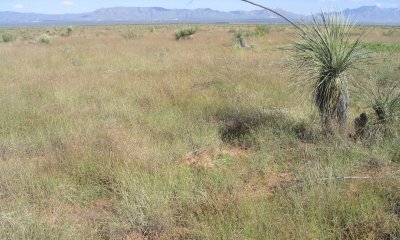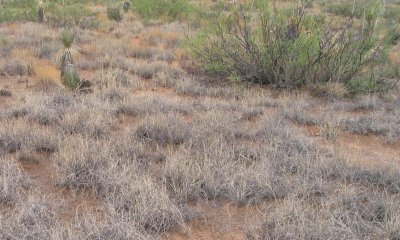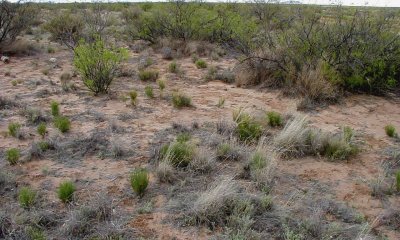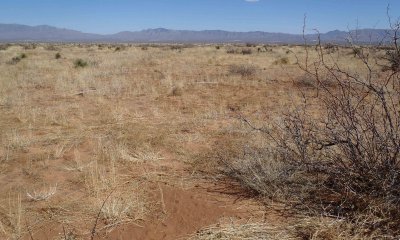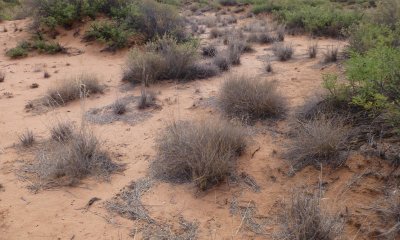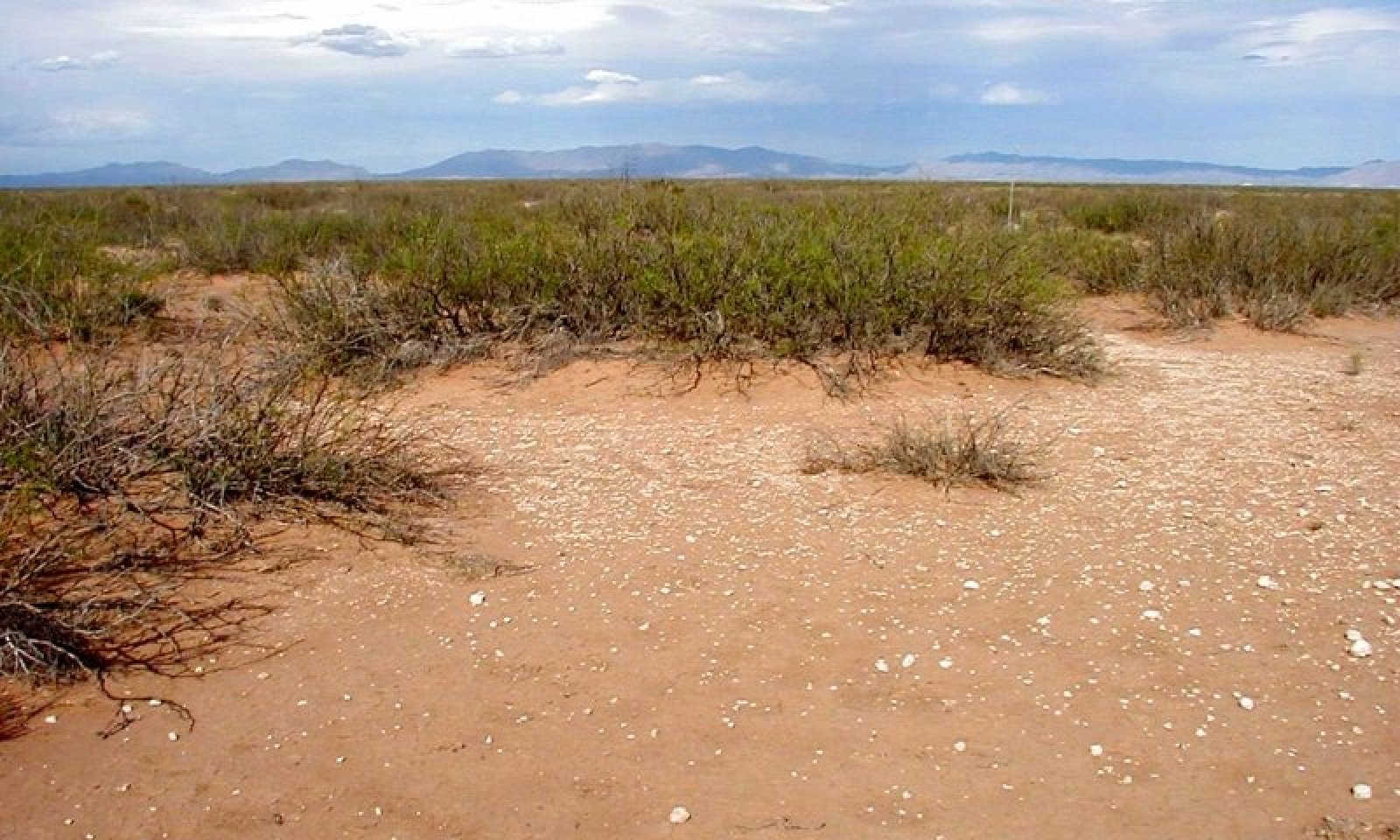
Sandy, Desert Shrub
Scenario model
Current ecosystem state
Select a state
Management practices/drivers
Select a transition or restoration pathway
-
Transition T1a
State 1 to 2: Mesquite establishment facilitated by seed transport by cattle, bare patches > 50 cm, and relatively wet springs.
More details -
Transition T1b
State 1 to 3: Black grama is reduced to ca. 5% foliar cover by heavy grazing in drought.
More details -
Restoration pathway R1
State 2 to 1: Shrub removal via herbicide (possibly fire) followed by black grama recovery.
More details -
Transition T2a
State 2 to 3: Black grama is reduced below ca. 5% foliar cover by heaving grazing in drought.
More details -
Transition T2b
State 2 to 4: At perennial grass cover <5%, wind and storm events trigger deep, spreading soil erosion.
More details -
Transition T3a
State 3 to 4: At perennial grass cover <5%, wind and storm events trigger deep, spreading soil erosion.
More details -
Transition T3b
State 3 to 5: Invasion and spread of Lehmann lovegrass.
More details -
Transition T4a
State 4 to 6: Sequences of wet years lead to colonization of bunchgrasses.
More details -
Transition T6a
State 6 to 4: Drought or overgrazing leads to widespread mortality of bunchgrasses.
More details -
No transition or restoration pathway between the selected states has been described
Target ecosystem state
Select a state
Description
The historic plant community is dominated by black grama (Bouteloua eriopoda) and dropseeds (Sporobolus flexuosus, S. cryptandrus, and S. contractus) may be secondary dominants. Bush muhly (Muhlenbergia porteri) and threeawns (Aristida spp.) are other common grasses. Soaptree yucca (Yucca elata), longleaf ephedra (Ephedra trifurca), sand sage (Artemisia filifolia), and snakeweed (Gutierrezia sarothrae) are common shrubs. Through its high basal cover, high litter cover, and consequent low rates of erosion and high infiltration rates, black grama can regenerate through tillering and possibly by seed in some years.
Overutilization of black grama and increasing rates of soil erosion and deposition when bare ground cover is high may result in an increasing relative abundance of dropseeds, threeawns, or snakeweed. It is also possible that in coarser soils, such as loamy sands, dropseeds dominate naturally. Two seasons without summer rains will also lead to black grama decline, but grasses such as dropseeds and threeawns are thought to be more sensitive to drought than black grama (Herbel et al. 1972). Snakeweed or dropseeds may become dominant within this state but black grama can gradually recover as long as some plants persist. Gibbens and Beck (1987) and Bestelmeyer et al. (2013) provide evidence for recovery of black grama within communities dominated by dropseeds or other plants. Campbell and Bombarger (1934) indicate that black grama can recover within snakeweed-dominated grassland.
Characteristics and indicators
Black grama is highly dominant and cover is largely continuous. There is evidence of black grama reproduction by stolon and possibly by seed. There are few large bare gaps (>1 m). Litter cover is abundant. Soil stability values range from 4-6 and poorly-developed biological crusts (Pedoderm class PDB) may be common in wet periods. Mesquite (Prosopis glandulosa) is sparse or absent (< 5% foliar cover). Black grama foliar cover levels approaching 5%, especially with loss of plants in large patches, should be cause for concern.
Resilience management
Black grama is the key plant of this site class due to its dominance in recent history, its high forage value, and its consequent sensitivity to grazing. Shifts away from black grama dominance are due to overgrazing and/or multi-year periods of summer or spring drought, or due to an accelerated rate of honey mesquite (Prosopis glandulosa) seed flow into black grama grassland and the establishment and growth of these shrubs. Continuous heavy grazing leads to declines in the proportional representation of black grama declines because it is preferred by cattle over other species, particularly outside the growing season (Paulsen and Ares 1962). Once black grama is locally extirpated, it tends not to recover because reproduction is primarily vegetative via stolons (Canfield 1939, Neilson 1986). Competition for water with neighboring shrubs, particularly in drought, can also limit grass growth, survival, and reestablishment (Snyder and Tartowski 2006).
Consequently, resilience of the black grama grassland state is focused on 1) grazing management to avoid substantial reductions of black grama and 2) control of mesquite shrubs when mesquite recruitment is occurring. Stocking rates and grazing periods that leave stems (stolons) long enough for new plants (ramets) to take root and adequate cover to protect soils through the spring windy season is critical. This management apparently allowed black grama populations to survive extreme drought episodes in the 1930s and 1950s that led to B. eriopoda losses elsewhere (Bestelmeyer et al., 2013). Timely control of mesquite using aerial or spot treatments of a foliar herbicide blend (see http://aces.nmsu.edu/pubs/_b/B822/welcome.html). Herbicide treatment should be considered when there is evidence that mesquite recruitment is occurring. Individual, large mesquite plants, however, may be desirable wildlife habitat elements.
Submodel
Description
Black grama continues to be the dominant perennial grass, but mesquite cover is sufficiently high to compete for space and resources with grasses. Mesquite plants may be very small and difficult to detect. Although fire may kill small (< 1.5 yr old; Wright et al. 1976) mesquite, it is unlikely that fire frequencies have been sufficient to remove mesquite from a grassland once a source of mesquite propagules has been connected to a grassland. Valentine (1936) indicates that beyond a height of 1-2 feet, mesquite begins to exclude grasses from around plant bases.
Characteristics and indicators
Black grama is the dominant perennial grass and mesquite are present and usually conspicuous, exceeding 5% foliar cover when leafed out. Black grama cover may be substantial but areas around shrubs devoid of grass. Typically, large patches devoid of black grama are common. Black grama foliar cover levels approaching 5% should be cause for concern.
Resilience management
Management of black grama is similar to State 1, but there should be additional concern for the effects of competition with shrubs, especially mesquite (P. glandulosa). Bestelmeyer et al. (2013) showed that, under heavy grazing pressure, the presence of shrubs (estimated at 7% foliar cover) increased the loss of black grama. Thus, managers might consider more conservative stocking rates in the presence of shrubs than indicated by grass production alone.
Pierce et al. (2018) found that removal of shrubs, on a gradient from 2-18% foliar cover of mesquite, resulted in a doubling of black grama production and reproduction. Brush control using herbicides (e.g. 2,4,5-T) resulting in at least a 30% mesquite kill can result in increases in grasses (Herbel et al. 1983). Newer herbicides, such as remedy/reclaim or sendero with electrostatic application may be most effective at killing shrubs. The use of fire may also be possible in more productive environments with continuous grass cover and wetter climates (average >10" per year). Wright et al. (1976) observed that honey mesquite less than 2-3 years old were killed by fire, apparently because the bud zone meristem was still exposed. Older mesquite tolerate fire or other disturbances by resprouting from the bud zone if above ground parts are destroyed or damaged. Fire, however, may damage or kill black grama plants and reduce reproduction in more arid parts of Chihuahuan Desert (9” annual precipitation), especially if fires are followed by drought (Drewa et al. 2006).
Submodel
Description
Bunchgrasses, including dropseeds (Sporobolus airoides, S. cryptandrus, and S. contractus) and threeawns (Aristida purpurea, A. ternipes) are the dominant perennials grasses and black grama is rare (<5%).
Characteristics and indicators
Black grama foliar cover is < 5% and lower than that of bunchgrasses, but total plant canopy cover may range from 60-75% where perennial grasses remain healthy. Black grama exists as isolated patches, often featuring evidence of soil aggradation within these patches and soil erosion surrounding the patches where bunchgrasses occur (soil redistribution class is 3a). The % of a line transect in gaps >1 m may range from 37-56%. Poorly developed biological crusts (pedoderm PDB) are rare, but average surface soil stability values range from 3-5, subsurface (2.5 cm) values are 1-2. Mesquite cover is variable, but usually > 5% and must be < 15%.
Submodel
Description
Mesquite are dominant and intershrub areas are typically eroded with a sparse vegetation cover of annual plants, perennial forbs, and subshrubs. On soils that are moderately deep or deep to restrictive soil horizons, soil accumulates on mesquite to form coppice dunes (or nabkas; Langford 2000) over time, which attain heights over 2 m on deeper soils. Saltbush (Atriplex canescens) may be common in mesquite coppice dunes. Perennial grasses, restricted to bunchgrasses, may establish and attain high cover in shrub interspaces during sequences of wet years (Peters et al., 2014). In other periods, grasses cannot establish due to soil water limitations, the instability of the substrate, and rodent and lagomorph herbivory on grass seedlings. In some cases, soil truncation exposes clay- and carbonate-rich subsoil that is very hard and does not permit plant establishment.
Characteristics and indicators
Mesquite is dominant and may form coppice dunes from 0.5-3 m high. Bunchgrasses are usually absent or restricted to coppice dunes. In extremely wet years, bush muhly, threeawns, and dropseeds may colonize interdunes . There is usually abundant evidence of wind erosion and deposition including extreme pedestalling, plant burial, highly sorted sand, ripples, and an exposed B horizon in interdunes.
Resilience management
Grazing rest during wet seasons to promote a transition to a Grassy shrubland state.
Description
Lehmann lovegrass monocultures occur, often as large patches occurring within areas otherwise dominated by bunchgrass/mesquite states.
Characteristics and indicators
Lehmann lovegrass is the dominant perennial grass.
Resilience management
Fire may promote Lehmann lovegrass dominance, but fire is rare in typic aridic, thermic soil climates. Little is known about management practices to promote or limit its expansion.
Description
Formerly a community phase within the shrubland state, recent evidence suggests the grassy shrubland is a persistent state. Abundant cover of bunchgrasses, including bush muhly, dropseeds, and threeawns in the interspaces of mesquite shrubs or coppice dunes. Grass patches may accumulate soil and litter, creating environments that favor grass establishment and persistence. Black grama is not known to colonize shrubland states.
Characteristics and indicators
Mesquite is dominant, and bunchgrass cover may be patchy or co-dominant with mesquite (up to 30% foliare cover) nearly continuous in mesquite interspaces. Soil accumulation may be observed.
Resilience management
Care should be taken to manage grazing use to promote bunchgrass survival and recruitment during dry years. Severe drought may lead to a transition back to the shrubland state irrespective of grazing management.
Mechanism
Mesquite establishment rate is thought to be accelerated by 1) increased seed availability when cattle forage in shrubby areas and then transport and defecate mesquite seeds in grass-dominated patches and 2) reduced perennial grass cover that reduces competition for surface soil water between grasses and shrub seedlings. On the other hand, Herbel and Gibbens (1996) suggest that mesquite invasion can occur within apparently intact black grama stands, suggesting that competition may be less important than seed dispersal. In addition, a reduction of historical fire frequencies associated with fragmentation of perennial grass cover has been proposed, but there is little evidence that fire can be used to limit mesquite establishment in all but the most productive landscapes due to natural limitations in fuel continuity. The factors that have led to existing variations in mesquite density within black grama grasslands are poorly understood.
Constraints to recovery
Once established, mesquite shrubs are unlikely to suffer natural mortality due to drought, herbivory, or age (Goslee et al. 2003). Mesquite can live at least 60 years on the Jornada Experimental Range in south-central New Mexico and in desert grasslands of the Santa Rita Experimental Range in southeastern Arizona, mesquite live for over 200 years (McClaran 2003). Consequently, the spread of mesquite in black grama grasslands tends to accelerate over time without mesquite control (Goolsby 2012).
Context dependence
Increases in mesquite dominance within grasslands and associated grass declines have been shown to be distance-dependent (Yao et al. 2006, Goolsby 2012). Subsoil texture also controls the rate of shrub spread and grass loss over decadal timescales (Browning et al. 2012). Soils that are deep and with lower maximum clay content (9%) in the top 100 cm experienced a much faster rate of shrub encroachment than soils that had a root-limiting horizon (a petrocalcic or "caliche" layer) and higher maximum clay content (13.5 %) within the top 100 cm.
Mechanism
Overgrazing of black grama plants in the context of multi-year drought is known to cause black grama mortality and persistent black grama reductions or extinction from large areas (Bestelmeyer et al. 2011), which may subsequently become dominated by bunchgrasses. The loss of perennial grass cover may create opportunities for mesquite shrub establishment and gradual increases in shrub dominance (see Transition 1a).
Constraints to recovery
Black grama does not recover due to limitations in seed establishment, and because too few plants are available to recolonize areas vegetatively.
Context dependence
It is suspected that this transition is most likely on soils that are > 1 m deep to a petrocalcic (caliche) horizon and have relatively low clay content, but this has not yet been quantified.
Mechanism
Mesquite can be killed by application of foliar herbicides (see http://aces.nmsu.edu/pubs/_b/B822/welcome.html). Black grama recovery into large bare patches surrounding killed shrubs can occur over time via clonal growth, or areas may be colonized initially by other grasses such as Sporobolus species.
At this point, it is unclear if fire can be effectively used as a management tool to promote black grama dominance in most areas within MLRA 42. In sandy ecological sites in wetter areas (above 10 inches mean annual precipitation, not R042XB012NM), fire might be used as a tool to prevent mesquite regrowth or reestablishment. The successful use of fire in black grama grasslands, however, depends strongly upon the size of mesquite and probably on post-fire precipitation patterns that favor black grama recovery (Drewa and Havstad 2001).
Context dependence
Causes of spatial or temporal variations in the efficacy of herbicides is unknown. There is no evidence of fire promoting black grama dominance in LRU 42.2.
Mechanism
Overgrazing of black grama plants in the context of multi-year drought is known to cause black grama mortality and persistent black grama reductions or extinction from large areas (Bestelmeyer et al. 2011), which may subsequently become dominated by bunchgrasses. An increased density of shrubs in state 2 exacerbates black grama loss by constraining recovery during wet years and hastening grass mortality due to competition for soil water (Pierce et al., 2018) .
Constraints to recovery
Black grama does not recover due to limitations in seed establishment, and because too few plants are available to recolonize areas vegetatively.
Context dependence
It is suspected that this transition is most likely on soils that are > 1 m deep to a petrocalcic (caliche) horizon and have relatively low clay content, but this has not yet been quantified.
Mechanism
Loss of interspace grass cover due to heavy grazing and/or drought leads to increasing erosion and redistribution of soil to shrubs (Schlesinger et al., 1990) and out of the site (Gillette and Monger 2006). Erosion leads to loss of remaining grasses due to soil destabilization, exacerbated by increasingly concentrated rodent and livestock herbivory on grasses. Sediment deposition around mesquite shrubs leads to coppice dune formation. The factors responsible for the apparently great variation in the occurrence of this transition are not well understood.
Constraints to recovery
Accelerated wind erosion, sediment transport, and abrasion of grass seedlings is likely an important constraint to overall grass recovery, alongside seedling and grass herbivory by rodents and lagomorphs. Exposure of infertile soil horizons at the surface may also limit grass recovery. In addition, black grama recovery from seed is rarely observed due to unknown recruitment limitations in this climatic zone.
Context dependence
Grass loss and shrub encroachment has been observed to be more rapid on weakly developed soils without significant carbonate or clay accumulation (Browning et al. 2012).
Mechanism
Similar to transition 2b: Loss of interspace grass cover due to heavy grazing and/or drought leads to increasing erosion and redistribution of soil to shrubs (Schlesinger et al., 1990) and out of the site (Gillette and Monger 2006). Erosion leads to loss of remaining grasses due to soil destabilization, exacerbated by increasingly concentrated rodent and livestock herbivory on grasses. Sediment deposition around mesquite shrubs leads to coppice dune formation. The factors responsible for the apparently great variation in the occurrence of this transition are not well understood.
Constraints to recovery
Similar to transition 2b: Accelerated wind erosion, sediment transport, and abrasion of grass seedlings is likely an important constraint to overall grass recovery, alongside seedling and grass herbivory by rodents and lagomorphs. Exposure of infertile soil horizons at the surface may also limit grass recovery. In addition, black grama recovery from seed is rarely observed due to unknown recruitment limitations in this climatic zone.
Context dependence
Similar to transition 2b: Grass loss and shrub encroachment has been observed to be more rapid on weakly developed soils without significant carbonate or clay accumulation (Browning et al. 2012).
Mechanism
Lehmann lovegrass invades (usually associated with deliberately introduced seed used in roadside plantings) and becomes dominant, particularly during wet years. The circumstances under which lovegrass dominance occurs are unknown, but high late spring/early summer precipitation and warmer temperatures might promote this species.
Constraints to recovery
Lehmann lovegrass patches persist and spread, especially during wet years.
Context dependence
None yet known.
Mechanism
Sequences of wet summers in the context of limited grazing use can catalyze bunchgrass establishment, sometimes featuring multiple establishment events in growing season (Peters et al. 2014).
Constraints to recovery
The formation of bunchgrass patches leads to soil stabilization and soil and litter accumulation, which might increase seasonal soil water availability. The abundance of plants might also surpass a threshold beyond which rodent and lagomorph herbivory has reduced impact on overall grass survival and recruitment.
Context dependence
This transition is not possible on soil or soil patches that have eroded to clay-rich hardpans.
Model keys
Briefcase
Add ecological sites and Major Land Resource Areas to your briefcase by clicking on the briefcase (![]() ) icon wherever it occurs. Drag and drop items to reorder. Cookies are used to store briefcase items between browsing sessions. Because of this, the number of items that can be added to your briefcase is limited, and briefcase items added on one device and browser cannot be accessed from another device or browser. Users who do not wish to place cookies on their devices should not use the briefcase tool. Briefcase cookies serve no other purpose than described here and are deleted whenever browsing history is cleared.
) icon wherever it occurs. Drag and drop items to reorder. Cookies are used to store briefcase items between browsing sessions. Because of this, the number of items that can be added to your briefcase is limited, and briefcase items added on one device and browser cannot be accessed from another device or browser. Users who do not wish to place cookies on their devices should not use the briefcase tool. Briefcase cookies serve no other purpose than described here and are deleted whenever browsing history is cleared.
Ecological sites
Major Land Resource Areas
The Ecosystem Dynamics Interpretive Tool is an information system framework developed by the USDA-ARS Jornada Experimental Range, USDA Natural Resources Conservation Service, and New Mexico State University.
